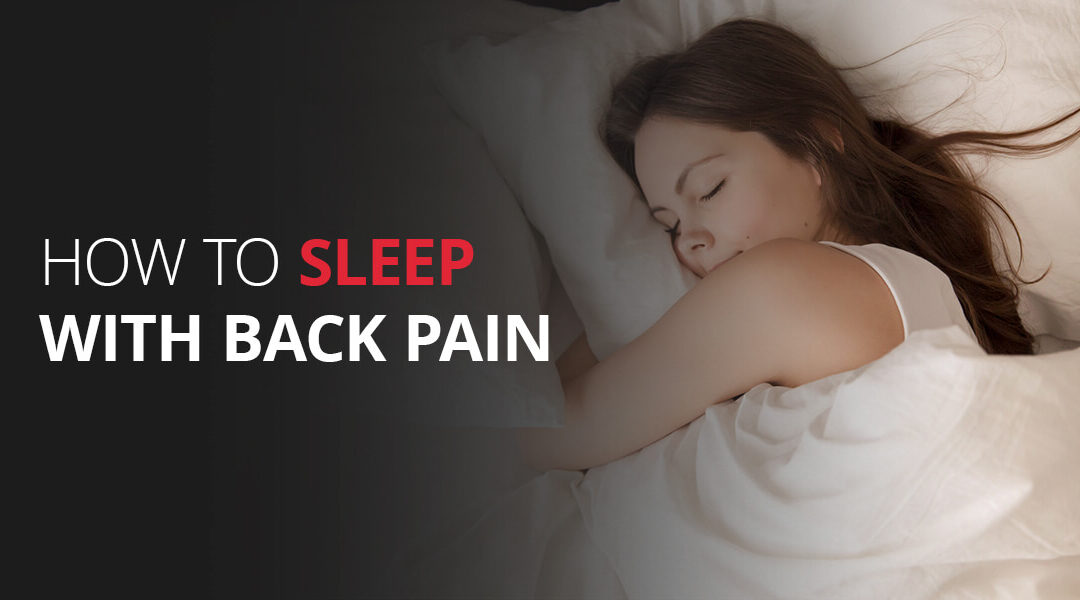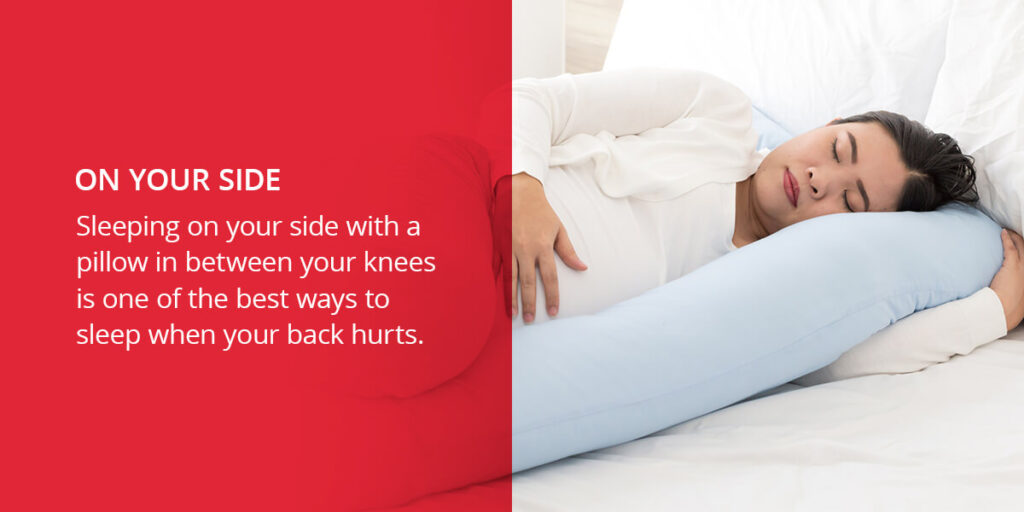Ever wonder how to sleep with a hurt back? Back pain when sleeping is never fun, and it impacts your overall health. Your quality of sleep is important to your general health. Humans spend approximately one-third of their lives sleeping, so getting a good night’s rest is vital to your daily life. Sleeping with back pain is difficult, but there are some ways you can alleviate it while getting a good night’s rest.
Waking up with a stiff back is attributed to several factors including:
- Sleep positions
- Type of mattress
- Choice and placement of pillows
Whether you suffer from acute or chronic back pain, your quality of sleep is likely diminished. According to the Mayo Clinic, poor sleep and a lack of sleep leads to a range of other issues including a lowered and weakened immune system. Fight your back pain at night by sleeping in an optimal position and on the right type of mattress with the correct pillows.
Best Way to Sleep For Your Back
Many times, you can reduce and sometimes even eliminate your back pain by sleeping in the right position with plenty of added support. One of the best ways to get quality sleep and reduce back pain is to ensure you’re sleeping in a comfortable position that keeps your spine, head and neck aligned and straight to reduce pressure across areas of your back. According to the Mayo Clinic, making changes to your sleep positions will take the strain off your back and lead to a better quality of sleep.
Fetal Position
The fetal position takes the pressure off of areas of your back and offers you a better night’s sleep by opening the space between vertebrae and reducing the curvature of your spine. Sleeping in the fetal position means sleeping on your side by taking your knees and tucking them into your chest. It’s called the fetal position due to the way it closely resembles the way a baby positions itself inside the mother’s womb.
On Your Stomach
Sleeping on your stomach is not recommended and you should try to avoid this position. When laying on your stomach, you’re putting pressure on areas of your back, particularly your lower back. If you suffer from lower back pain, then it’s best to avoid sleeping on your stomach. Laying on your stomach at night is one of the sleeping positions that cause back pain and will lead to waking up with a stiff back.
If you must sleep on your stomach, then you’ll want to place a pillow directly underneath your pelvis. This will help take the pressure off of your lower back by filling the gaps between your lower abdomen and the mattress. You can also consider sleeping with a very thin pillow under your head or with no pillow at all.
On Your Side
If you’re wondering how to sleep with lower back pain, sleeping on your side with a pillow in between your knees for optimal support is one of the best sleeping positions. Sleeping on your side with a pillow in between your knees is one of the best ways to sleep when your back hurts. Caring for your back pain by sleeping in the optimal position will not only reduce pain but also help you through your daily routines and stay productive.
Many times, sleeping on your side with a pillow between your knees reduces back lower pain by taking the pressure off of your back and keeping your spine, head and neck aligned properly. The pillow between your knees must be stable and not move or shift through the night to ensure you’re stacking your hips and keeping them aligned with your spine.
Wondering how to sleep with sciatica? If you suffer from sciatica pain, then sleeping on the side opposite of the pain is going to be your best bet. This will take pressure off of the side with sciatica issues.
Reclined Position
If you feel most comfortable sleeping in your favorite recliner, then you may want to consider investing in an adjustable bed that allows you to choose the optimal reclined position for the best alignment and support to meet your sleeping needs. Sleeping in a reclined position keeps your head and back in a curved position and can reduce pressure on your lower back through the night by keeping your trunk upright and your airways open.
The angle between your thighs and trunk will reduce pressure on your spine and potentially decrease your lower back pain overnight. However, this is not always the best way to sleep because it can cause knee and hip contractures, which in turn leads to increased pain and further issues getting a quality night’s sleep. Sleeping in a reclined position also restricts blood flow and circulation, which can create more problems than it solves.
Flat On Your Back
If you’re looking for ways to sleep with middle back pain, then sleeping flat on your back with a pillow under the small of your back can help alleviate your pain. Sleeping flat on your back distributes your weight evenly, spreading it across the widest areas of your body and taking pressure off your spine. This puts less stress and strain on pressure points and offers better alignment of your spine and internal organs, eliminating middle and upper back pain.
Sleeping flat on your back with extra support or pillows under the small of your back can also offer an optimal way to sleep with sciatica pain.
Alignment is Key
Regardless of the position in which you choose to sleep, keeping your spine, hips, head and neck aligned properly without added pressure is key to sleeping with back pain. By keeping your spine aligned with your head and neck, you’ll reduce pressure on areas of your back and receive a higher quality night’s sleep.
When thinking about alignment, it is important to also choose the right support pillows and a mattress with the optimal firmness level to reduce gaps between your body and your mattress. These gaps between your body and mattress are capable of creating pressure and causing back pain.
Choosing the Right Pillow
Many times, you can alleviate back pain while sleeping by choosing the right thickness and firmness of your pillow or pillows. If you’re sleeping on your side with a pillow between your knees, then you’ll want to use a pillow with the right thickness and firmness to ensure you’re keeping your spine and hips aligned properly and adequately reducing pressure or stress on your back.
Thickness
Choosing a thickness for your pillow depends on the position in which you’re most comfortable sleeping. Sleeping on your stomach likely means you’ll want to opt for a thinner pillow for your head. Likewise, sleeping on your side with a pillow between your knees requires choosing a pillow that is thick enough to keep your knees far enough apart while keeping your hips stacked and aligned with your spine.
Sleeping flat on your back means choosing a pillow that’s thin enough to fill the gaps between the small of your back and your mattress while not causing your lower back to curve too much, creating more pressure on the middle of your back. The thickness of your pillow is essential to a good night’s sleep. Make sure your pillow is thick enough to fill the gaps between your body and your mattress without creating any additional pressure points on your back.
Firmness
Just as choosing the right thickness for your pillow is important, deciding on the firmness of your pillow is equally as important. Depending on the position in which you sleep, you’ll need to consider choosing a pillow that is not only right for your head, but also one that’s right for keeping between your knees or under your back and stomach. A firm pillow that offers the support you need will reduce pressure and keep your neck properly aligned with your spine.
Likewise, a pillow that is too soft creates improper alignment of your neck, hips and spine by not offering enough support in those areas. Experiment using different pillows with varying levels of firmness before laying down to sleep for the night. Just be sure that it’s keeping your body in alignment when you decide which pillow is right for you.
Best Mattresses for Back Pain
There are many different types of mattresses to choose from, but choosing the best mattress for back pain can be tricky. It’s important to note that there is no right bed for everyone. You’ll want to research and test the best type of mattress that suits your sleep and meets your comfort needs.
Here are a few of the different types of mattresses:
- Memory foam and latex
- Innerspring
- Hybrid
- Waterbeds
These are just a few of the types of mattresses available on the market. Choosing the right one to meet your needs may eliminate some of your issues as well as prevent you from waking up with back pain altogether. Consider choosing a mattress with adequate support. Support is vital to maintaining spinal alignment.
Let’s take a closer look at the different types of mattresses to help you choose the best mattress for back pain.
Memory Foam and Latex
Memory foam mattresses provide support by molding to the shape of your body and staying like that, hence the name memory foam. Memory foam comes in three different types:
- Traditional
- Open-cell
- Gel-infused
Choosing the best mattress for back pain is an inexact science that requires you to decide the firmness and thickness that’s right for you. However, memory foam and latex mattresses are highly recommended for back pain because of the unique and personalized support they offer.
Innerspring
Innerspring mattresses are traditional mattresses constructed using springs or coils. They are not typically recommended for those of you suffering from back pain because they simply don’t offer enough support where you need it most. The areas between the springs or coils do not provide you with an even level of support from end to end. The uneven distribution of weight and support makes innerspring mattresses an unattractive option when choosing a mattress.
Hybrid
Hybrid mattresses are a combination of innerspring and memory foam. They’re usually innerspring mattresses with a memory foam topper. Similar to all innerspring mattresses, these don’t typically offer enough support to help alleviate your back pain. The memory foam toppers are typically too thin to offer enough support and they don’t outweigh the downside of the innerspring mattresses.
Waterbeds
Although waterbeds are not as stylish as they once were, some people still prefer them over traditional mattress types. If you’re wondering whether or not waterbeds are good for your back, then it’s important to know that there simply isn’t enough research to say one way or another. However, if you’re comfortable sleeping on a waterbed, then please go for it.
Reduce Potential Sleep Disruptions
One key to sleeping with back pain is reducing potential disruptions through the night. If your back pain is preventing sleep, then don’t compound the issue with additional disruptions. Adults need approximately seven to nine hours of quality sleep every night with teenagers, infants and toddlers requiring more. Avoid and eliminate these potential sleep disruptions to help get the rest needed for a healthy, productive and back pain-free day.
Avoid Alcohol and Caffeine
Alcohol and caffeine can disrupt your sleep, and they can cause difficulty both falling and staying asleep. Sleeping with back pain is tough enough without compounding the problems of consuming too much alcohol and caffeine close to bedtime.
Eliminate Noise and Light
Exposure to noise and light is likely to disrupt your sleep. Consider investing in earplugs to help you drown out street noise and other loud nuisances to help you sleep better. Also, be sure to turn off the television when you lay down to sleep for the night. The television pumps unnecessary light and noise into your sleeping environment, and it’s recommended that you limit television time before going off to bed.
You can also consider using a sleep mask to help block light sources when you’re sleeping. Streetlights, car headlights and you need to block any lights coming from the television when you lay down for the night.
Set the Right Temperature
Choosing the right temperature at night is vital to your quality of sleep. You’ll want to set your thermostat to a cool 68 to 70 degrees and keep your sleeping environment cool at night. Your optimal temperature at night is a personal preference, but if you find yourself waking up to your blankets off and laying on the floor, then chances are you need to adjust your thermostat to make it cooler in your room at night.
Twist and Turn With a Tight Core
If you’re uncomfortable or often disturbed through the night, then chances are you’re twisting and turning as well. You’ll also want to stay aligned and prevent any stress or pressure when turning over throughout the night. As you turn over and change sleeping positions, be sure to turn with a tight core and avoid unnecessary twisting or straining. Tighten your core when you turn or twist through the night by pulling your knees toward your chest and keeping your entire body together.
Contact Thrive Chiropractic Group
If you’re having trouble sleeping due to back pain, then reach out to Thrive Chiropractic Group for customized tips and advice. Thrive Chiropractic Group offers help finding long-term solutions for your acute or chronic back pain issues. We take pride in delivering personalized chiropractic solutions for the great people in the Oklahoma City area.
Don’t just survive, thrive!
Call to make an appointment or fill out our online form to schedule your appointment today.





